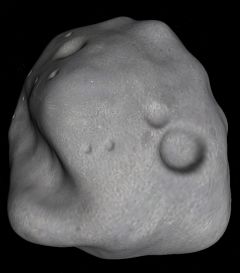21 Lutetia
Revision as of 12:35, 9 November 2024 by Arvil (talk | contribs) (Arvil moved page User:Arvil/Sandbox02 to 21 Lutetia: Move to article page.)
| 21 Lutetia | |
|---|---|

| |
| 21 Lutetia from Asteroid 3D.zip in Orbiter 2016 with D3D9 | |
| Designation | |
| Name | 21 Lutetia |
| Reference body | Sun |
| Planetary mean orbits | |
| Epoch | 2010.53388090349 |
| Semimajor axis (a) | 364408484044.597 m |
| Eccentricity (e) | 0.16286473960148 |
| Inclination (i) | 3.06374072792851° (0.0534723631298002 radian) |
| Longitude of the ascending node (LAN, ☊) | 80.8998327325661° (1.41196844549596 radian) |
| Longitude of periapsis (ϖ) | 331.089477757921° (5.77860150558426 radian) |
| Mean longitude (L) | 563.06842926337° (9.82739800467859 radian) |
| Selected physical parameters | |
| Mean radius | 47900 km |
| Mass | 9.2×1017 kg |
| Rotation elements | |
| SidRotPeriod | 29419 seconds (8.1719 hours) |
| SidRotOffset | 0 |
| Obliqutiy | 0 |
| LAN | 0 |
| Note | *Elements given are from Lutetia.cfg (Asteroid 3D.zip) |
21 Lutetia is a large asteroid in the main asteroid belt. It was discovered by Hermann Goldschmidt in November 1852 and was named Lutetia, the latin name for Paris. Lutetia was visited by the Rosetta spacecraft in July 2010.
21 Lutetia in Orbiter
21 Lutetia was first introduced with the release of Asteroid 3D.zip in November 2014. Note that the landing surface as given in the config file is spherical, but the visual of Lutetia is not, if you land, you will likely be above or below the visual surface.
| Add-on | Source | Version | Author | Type | Release Date | Compatibility | Wiki article |
|---|---|---|---|---|---|---|---|
| 3D Asteroids | O-F Resources | 2014-11-06 | T1234 | Scenery | 6 November 2014 | ||
See also
- 21 Lutetia at Wikipedia
- Rosetta mission at Wikipedia
Gallery
21 Lutetia imaged by Rosetta in July 2010
| edit The Solar System | |
|---|---|
| Central star |
Sun (Sol) |
| Planets |
Mercury - Venus - Earth - Mars - Jupiter - Saturn - Uranus - Neptune |
| Natural satellites |
Moon - Phobos - Deimos - Io - Europa - Ganymede - Titan - more... |
| Add-ons |
Planets - Dwarf Planets - Small objects - Natural satellites - Alternative star systems |


